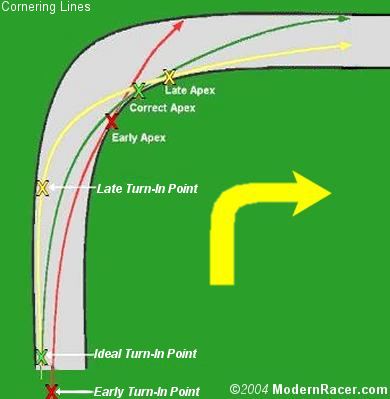These days motorycle riders must go through a much more rigorous training regimen than that which was the case when I got my licence. And yet it astonishes me that, even though all this training is done, many riders still have no idea of the concept of the “Right Line”
Start talking about it and they start to glaze over, like you’re speaking Spanish, or something. Go out with them on a ride and follow them through the corners and you sense that they either weren’t paying attention when the instructor was talking about this or they didn’t think it was important or whatever.
So, what IS the right line? Well, perhaps a diagram will be best here.

Now, as you can see, three different approaches to a corner are shown here.
Firstly, the “ideal ” line is shown in green. It is the classic, “wide out, brake early, shave the apex, gas it and go” line. This works perfectly on the race track which is, of course, where it came from.
Great on the track, not so much on the road, as we will see.
The “wrong” line is shown in red. It involves turning in from the middle of your own lane, hitting the apex of the corner early and running way too wide on the run out of the corner. Sad to say I have seen many riders riders using this line while I have been following along at the tail of the field on group rides. No criticism intended here, so please don’t take offence.
Using this line can work, it just means that you have to lean the bike more to negotiate the corner. I’ve actually seen some riders use this line by choice just because it enables them to achieve extreme lean angles. But it fails miserably when the corner tightens part way through and you find that you’ve already used up all the available ground clearance and road at the same time.
The “correct” line for riding on the road is called here the “late” line and it is shown in yellow. It is similar to the “ideal” line in that it involves braking early and accelerating early, but it has the added safety feature of giving the rider much better visibility through the corner than the “ideal” one does. If you imagine yourself riding that “ideal” line, you can see that there will be a part of the exit of the corner, just past the apex, that will be a blind spot for you.
On the track this is not an issue, but on the road it is.
Because traffic could be lurking in this blind spot, the “late” apex approach is preferable for safety reasons. It allows you to “see” through the corner; it still allows you complete your braking early; it allows a smooth progress through the corner without histionics and it allows early acceleration out of the corner. It doesn’t “straighten” the corner quite as much as the “ideal” line does, but I can live with that because of the increased safety.
That’s for a right-hander. For a Left-hand corner, just reverse the positions. It’s pretty simple, really, isn’t it?







